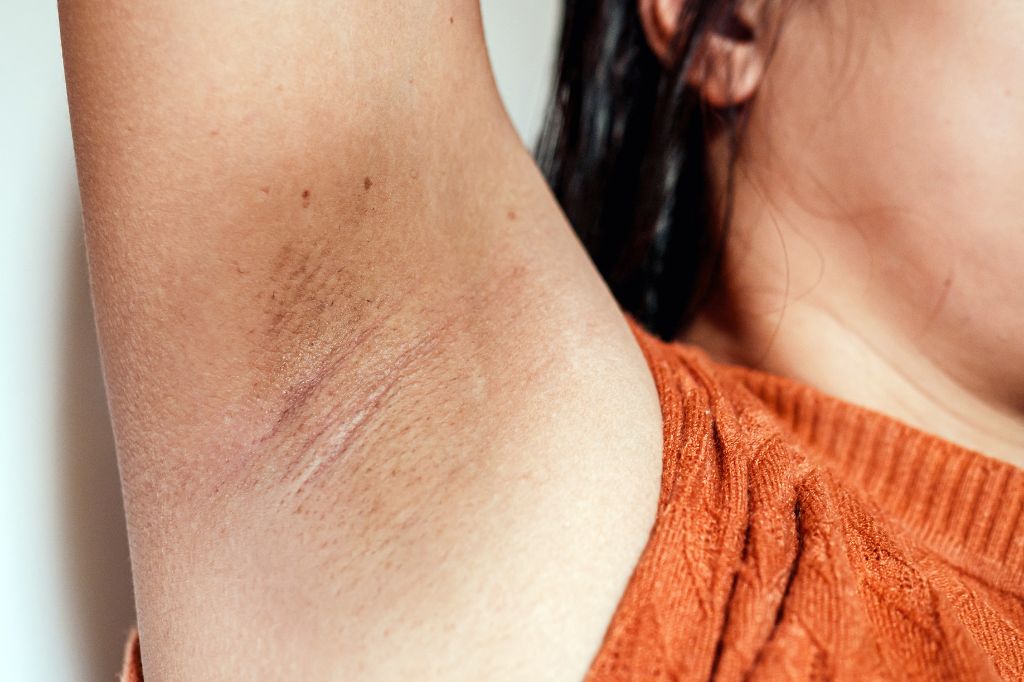An armpit rash can be uncomfortable and frustrating, especially when it keeps coming back or seems to have no clear cause. However, these rashes are more common than you might think. After all, the underarm area is warm, moist, and often exposed to friction and product buildup, making it especially prone to irritation.
Some armpit rashes come on suddenly and clear up within a few days. Others linger, return frequently, or worsen despite your best efforts to treat them at home. At Cascade Eye & Skin Centers, our dermatology providers can help you figure out what’s causing your armpit rash and guide you toward lasting relief.

7 Common Causes of an Armpit Rash
1. Irritant or Allergic Contact Dermatitis
This is one of the most common causes of an armpit rash. It occurs when the skin reacts to a substance applied to the area, either due to irritation or a true allergic reaction.
Deodorants and antiperspirants are a frequent trigger. Ingredients in these products that can cause problems include:
- Fragrance and preservatives in both traditional and natural deodorants
- Baking soda, which can alter the skin’s pH and cause irritation
- Essential oils, even the ones labeled as natural, can still cause irritation
- Aluminum in traditional deodorant and antiperspirant products may also trigger irritation or block pores
Rashes under the armpit are becoming more common as more people switch to natural deodorants, which are gaining popularity. This may be due to baking soda, essential oils, or other natural ingredients that the body is not used to irritating the skin.
Some individuals also experience a “detox period” as their sweat glands adjust to the new product, which can lead to increased sensitivity or redness under the arms.
If your armpit rash appeared shortly after trying a new deodorant or body product, contact dermatitis is a likely cause.
2. Friction and Sweat (Intertrigo)
The underarm area is prone to chafing, sweating, and trapped moisture, especially during warmer months or after exercise. This can lead to a condition called intertrigo, a red, inflamed rash that thrives in skin folds.
The combination of friction, heat, and humidity can also lead to:
- Skin breakdown
- Odor or secondary bacterial/fungal infection
- Stinging, burning, or itching sensations
Wearing tight or non-breathable clothing can worsen this condition.
3. Fungal or Yeast Infections
The armpit provides the ideal environment for yeast and fungi to grow. Candida, a type of yeast, is particularly common in this area and can cause a red, itchy, and sometimes scaly rash, often with small bumps or pustules just outside the main rash area.
People with weakened immune systems, diabetes, or a history of antibiotic use may be more prone to fungal infections in the underarms.
4. Bacterial Infections
Bacteria like Staphylococcus aureus can enter the skin through hair follicles or small cuts, leading to painful red bumps, oozing, or even abscesses. In some cases, a condition called hidradenitis suppurativa, a chronic inflammatory skin disorder, can lead to recurrent painful lumps under the arms that may resemble a rash early on.
5. Heat Rash (Miliaria)
Common in hot, humid conditions, heat rash happens when sweat glands become blocked, trapping perspiration under the skin. This can cause small red bumps, irritation, and an itching or prickling sensation in the armpits and other covered areas.
6. Eczema and Psoriasis
Chronic skin conditions like atopic dermatitis (eczema) or psoriasis can also appear in the underarms. These rashes may present as:
- Dry, itchy, scaly skin (eczema)
- Smooth, red, and shiny patches ( psoriasis)
7. Shaving and Hair Removal
Frequent shaving or waxing can irritate the underarm skin or lead to ingrown hairs, which may cause redness, bumps, and itching that resemble a rash. Using dull razors or skipping post-shave skincare can make this worse.
How to Treat an Armpit Rash at Home
For many mild rashes, gentle home care and short-term lifestyle changes may be enough to resolve symptoms.
Identify and Eliminate Triggers
- Stop using any new deodorant, body wash, or lotion that may have caused the reaction.
- Consider switching to fragrance-free, dermatologist-tested products.
- Avoid tight clothing that causes friction while the area heals.
Keep the Area Cool and Dry
- After showering, make sure to gently pat the underarms dry, rather than rubbing them.
- Use a clean towel and avoid sharing with others.
- Wear breathable fabrics, like cotton, to minimize sweat buildup.
Apply a Barrier or Soothing Cream
- Zinc oxide-based creams (like diaper rash creams) can protect and calm irritated skin.
- Over-the-counter hydrocortisone cream may help reduce inflammation in short-term cases, but avoid long-term use without guidance.
- For yeast-related rashes, antifungal creams with clotrimazole or miconazole may be helpful.
Stop Shaving Temporarily
If your rash is due to irritation or ingrown hairs, give your skin time to recover by avoiding shaving or waxing until the rash clears.
Get Real Answers for Persistent Underarm Rashes
If you’re dealing with a rash under your armpit that won’t go away, or one that keeps coming back, it’s worth checking in with a dermatologist. Our team at Cascade Eye & Skin Centers can help you get to the bottom of what’s causing the irritation and recommend treatments that actually work for your skin.
Whether you need prescription care, product guidance, or a plan to prevent future flare-ups, we’re here to help you feel more comfortable in your skin again.
Click here to schedule a dermatology appointment with us today.






